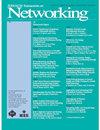多无人机物联网设备数据采集的能源和时间权衡优化
IF 3
3区 计算机科学
Q2 COMPUTER SCIENCE, HARDWARE & ARCHITECTURE
引用次数: 0
摘要
在本研究中,我们研究了在物联网(IoT)中调度多架无人机(UAV)进行数据采集的问题,每架无人机从其起点出发,访问一些物联网设备进行数据采集,然后返回其目的点。考虑到无人机有限的机载能量和从所有物联网设备收集数据所需的时间,必须合理分配每架无人机的数据收集任务,使每架无人机都不消耗过多的能量,并使所有无人机的最大任务完成时间最小化。为了优化这两个相互冲突的目标,我们通过联合设计每架无人机的飞行轨迹、悬停采集位置和飞行速度,关注所有无人机之间最大完成任务时间和最大能耗的最小化。我们将此问题表述为一个多目标优化问题,其目的是在时间或能量优势方面获得一组帕累托最优解。针对该问题的np -硬度和复杂性,提出了一种多策略多目标蚁群优化算法(MSMOACO),该算法是在约束蚁群优化算法的基础上,巧妙地结合了适应度引导突变策略和自适应悬停策略来求解该问题。为了适应实际场景,我们还设计了一种新的基于几何的避碰策略,以减少无人机之间碰撞的可能性。与以前的方法相比,广泛的评价验证了所提出的MSMOACO的有效性和优越性。本文章由计算机程序翻译,如有差异,请以英文原文为准。
Energy and Time Trade-Off Optimization for Multi-UAV Enabled Data Collection of IoT Devices
In this work, we study the problem of dispatching multiple unmanned aerial vehicles (UAVs) for data collection in internet of things (IoT), where each UAV departs from its start point, visits some IoT devices for data collection and returns to its destination point. Considering the UAV’s limited onboard energy and the time required to collect data from all IoT devices, it is essential to appropriately assign the data collection task for each UAV, such that none of the dispatched UAVs consumes excessive energy and the maximum task completion time among all UAVs is minimized. To optimize those two conflicting objectives, we focus on minimizing the maximum task completion time and the maximum energy consumption among all UAVs, by jointly designing the flight trajectory, hovering positions for data collection and flight speed of each UAV. We formulate this problem as a multi-objective optimization problem with the aim of obtaining a set of Pareto-optimal solutions in terms of time or energy dominance. Due to the NP-hardness and complexity of the formulated problem, we propose a multi-strategy multi-objective ant colony optimization algorithm (MSMOACO), which is developed based on a constrained ant colony optimization algorithm with a fitnessguided mutation strategy and an adaptive hovering strategy being delicately incorporated, to solve the problem. To accommodate the practical scenario, we also design a novel geometry-based collision avoidance strategy to reduce the possibility of collisions among UAVs. Extensive evaluations validate the effectiveness and superiority of the proposed MSMOACO, compared with previous approaches.
求助全文
通过发布文献求助,成功后即可免费获取论文全文。
去求助
来源期刊

IEEE/ACM Transactions on Networking
工程技术-电信学
CiteScore
8.20
自引率
5.40%
发文量
246
审稿时长
4-8 weeks
期刊介绍:
The IEEE/ACM Transactions on Networking’s high-level objective is to publish high-quality, original research results derived from theoretical or experimental exploration of the area of communication/computer networking, covering all sorts of information transport networks over all sorts of physical layer technologies, both wireline (all kinds of guided media: e.g., copper, optical) and wireless (e.g., radio-frequency, acoustic (e.g., underwater), infra-red), or hybrids of these. The journal welcomes applied contributions reporting on novel experiences and experiments with actual systems.
 求助内容:
求助内容: 应助结果提醒方式:
应助结果提醒方式:


